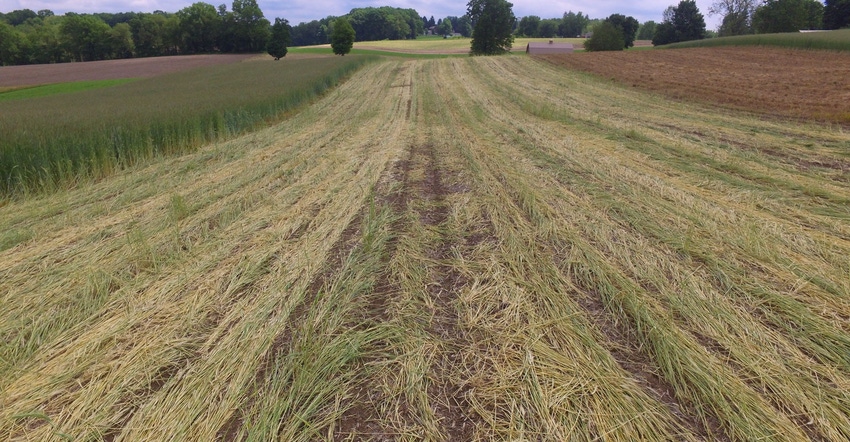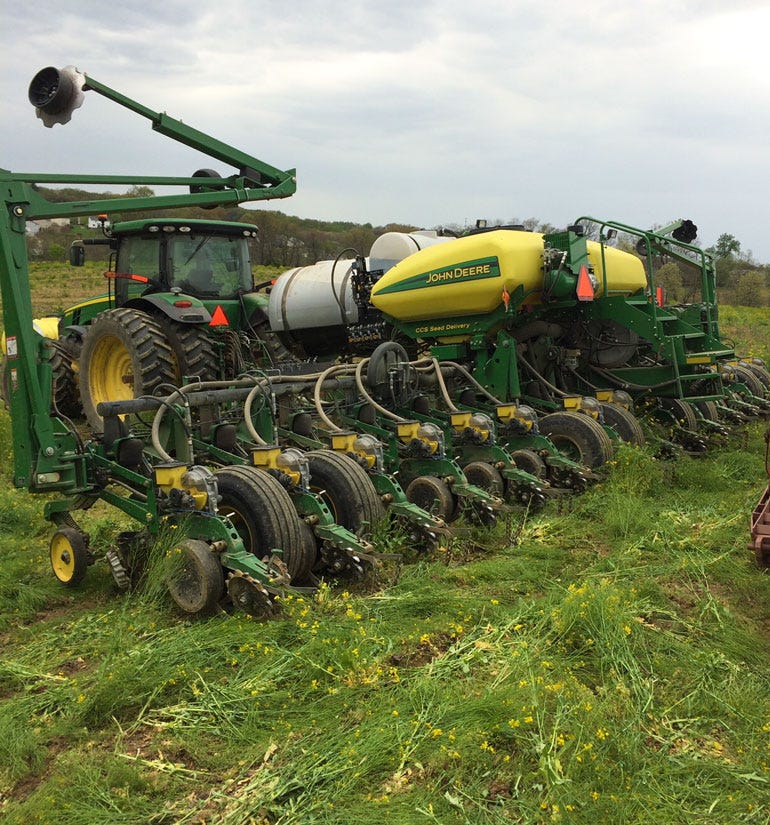March 18, 2019

By Carol Ann Gregg
Ed Thiele and Ryan Graham learned about planting green a few years ago.
Thiele attended a soil health workshop where Lucas Criswell, a farmer from Lewisburg, Pa., was the speaker. Criswell talked about his experience planting corn into high cover crops.
“I was impressed, and when I got home I watched several YouTube videos about planting green,” Thiele says.
That spring, in 2017, western Pennsylvania received a lot of rain during planting time. Thiele’s rye was growing by leaps and bounds, and it was time to plant corn.
Normally, Thiele, who farms with his wife, Lorraine, and their twin sons, James and William, would have sprayed the cover crop with a herbicide before planting, but with the conditions as they were, the family decided that they would try planting green.
“We were very pleased with the outcome,” Thiele says. “While William planted, I walked behind to see if the rye was wrapping, but there wasn’t a problem.”
They rolled down the tall rye with a cultipacker that they already had after drilling the corn.
The new seeding was top-dressed with urea and then the cover crop was sprayed with herbicide.
“The rolled rye made a golden mesh covering under the corn,” Thiele says. “It looked like we had bedded the plants with straw.”
Across the county from Thiele, Graham started trying more cover crops and planting green after being invited to join the board of the Pennsylvania No-Till Alliance.
“Attending no-till alliance events and board meetings opened my eyes to it,” Graham says. “It is amazing how far our reach is nationally. The president Jim Hershey has been honored for his top soybean production.”
A natural next step
Graham farms about 1,100 acres — 50 acres on his home farm, 280 acres on his parents’ farm and the rest on rented ground. He also custom-plants about 2,000 acres.
He has found that cover crops help get through dry spells, too.
Like anything that is done for the first time, there is a learning curve, Graham says.
“In my first attempt I seeded too heavy,” he says of the cover crop. “That created planting challenges.”
 CORN INTO GREEN: Ryan Graham says he likes planting corn into fields of mixed-species cover crops.
CORN INTO GREEN: Ryan Graham says he likes planting corn into fields of mixed-species cover crops.

That first year, he tried planting green in 30 to 40 acres.
The second year, he reduced his seeding rate of cover crops and planted green in 400 acres. This made planting green work much better, he says. He likes to use a cover crop mix, such as wheat, clover, radishes and rape.
“You need to watch the timing of what you plant,” he says.
Planting green was a natural next step for Graham. He and his dad have been no-tilling for 25 years and dabbling with cover crops for a while.
He grows corn, soybeans, wheat and some hay.
Last year, he planted green in 800 acres of cover crops.
“The cover crops are drilled within two days of the combine harvesting the corn or beans,” he says, adding that they have the best success with a drill to get the stand they want.
“It would be faster to spin the seed on, but we don’t get the stand that we want,” he says.
The cover crop gets up to a foot high just before planting. Graham hopes to be planting this year by May 1.
“We spray right after we plant to terminate cover crop,” he says. “We even tried it in a reseeding of a hayfield. We terminated the cover crop there as well.”
All for forage
The Thiele farm is a dairy operation with 40 cows.
“Our farm celebrated 150 years last year,” Ed Thiele says. They own 148 acres and farm a total of 300 acres. “Over the years, our priorities have always been children, cows, crops. Farming is an addiction. I love to experiment and learn.”
“I grow rye for the seed for the cover crops,” he adds. “On that field, I follow with a cover of mixed species. Last year, it was sunflowers, buckwheat, crimson clover, rye, radish and rape.
“If we plant early enough the sunflowers bloom. They can stop traffic.”
Thiele also grows alfalfa, grass hay and a mix of alfalfa and grass, all used as forage for the cows. “First-cut is all stored as haylage,” he says. He was told many years ago to park the planter and chop hay when it’s ready.
In 2018, he planted soybeans into rye cover using a corn planter with 15-inch rows. He says he made very few adjustments to his planter before planting into the rye cover.
“I changed to smooth closing wheels and removed the drag chains on my no-till planter,” he says.
Positive changes
Thiele and Graham say they have both seen an increase in organic matter in their fields. As they improve soil health they anticipate higher yields in their planted green fields.
In early March, the Butler County Conservation District honored Thiele Dairy Farm as Farm of the Year for its incorporation of conservation practices. At the same event, Graham was named Conservation Educator of the Year for his work with the Pennsylvania No-Till Alliance.
Gregg writes from western Pennsylvania.
You May Also Like




